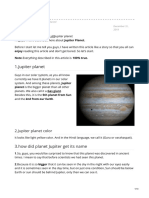The Dying Sun: The New Millennium Academy & Computer College
The Dying Sun: The New Millennium Academy & Computer College
Uploaded by
Mohsin AminCopyright:
Available Formats
The Dying Sun: The New Millennium Academy & Computer College
The Dying Sun: The New Millennium Academy & Computer College
Uploaded by
Mohsin AminOriginal Title
Copyright
Available Formats
Share this document
Did you find this document useful?
Is this content inappropriate?
Copyright:
Available Formats
The Dying Sun: The New Millennium Academy & Computer College
The Dying Sun: The New Millennium Academy & Computer College
Uploaded by
Mohsin AminCopyright:
Available Formats
THE NEW MILLENNIUM ACADEMY & COMPUTER COLLEGE
THE DYING SUN
(Sir James Jeans)
Q.1: What do you know about the size of the stars?
Ans: There are a few stars in the universe, which are hardly bigger than the earth. Mostly
they are hundreds of thousands times larger than the earth.
Q.2: How many stars are there in the universe?
OR
What comparison has the writer drawn to describe the total number of stars in
the universe?
Ans: Total number of stars in the universe is probably something like the total number of
grains of sand on all the seashores of the world.
Q.3: Draw a comparison between the earth and the other stars known in the universe.
Ans: Some of the other stars are very big. They are so big that millions of earths can be
packed inside each.
Q.4: What is the size of a large star?
Ans: A large star is so big that it can contain millions and millions of earths in it.
Q.5: How do the stars travel in the universe?
Ans: Millions of stars are wandering about in space. A few form groups which journey in
company, but most of them travel alone.
Q.6: Does one star come anywhere near to another?
Ans: The universe is so immense that it is a very rare event indeed for one star to come
anywhere near to another. Mostly the stars travel alone.
Q.7: How is it that a star seldom finds another star near it?
Ans: There are millions of stars in the universe. They are wandering about in space. One
star keeps a distance of over a million miles from its nearest neighbour. So a star seldom
finds another anywhere near it.
Q.8: Which scale model has the writer used to describe the position of stars in the
universe?
Ans: The writer has used the scale model of ships on an empty ocean. One ship is at the
distance over a million miles from the other ship.
Q.9: Why do the sun and the moon raise tides on the earth?
Ans: The sun and the moon raise tides on the earth because of their attraction.
Q.10: Why were the tides produced on the sun different from the tides produced on
the earth?
Ans: The tides produced on the surface of the sun were far bigger than those on the earth. It
was so because of the bigness of the sun as well as of the other star.
Q.11: What happened when, according to sir James Jeans, a wandering star,
wandering through space, came near the sun?
OR
Describe the tidal wave produced on the surface of the sun?
Ans: Sir James Jeans says that a rare event took place when a star came near the sun. Just as
the sun and moon raise tides on the earth, so this star must have raised tides on the surface
of the sun. It must have become an immense tidal wave that formed a very high mountain.
As the other star came nearer and nearer, the mountain would rise higher and higher.
Q.12: What happened on the surface of the sun when the other star began to move
away again?
Ans: When the other star began to move away again, the mountain was torn to pieces and
threw off small parts of itself into space.
Q.13: What are the planets and how did they come into existence?
PREPARED BY: MOHSIN AMIN
THE NEW MILLENNIUM ACADEMY & COMPUTER COLLEGE
Ans: The planets are the shattered and scattered pieces, which resulted from the break down
of the high mountain of tidal wave. These planets are great and small. Our earth is one of
them.
Q.14: Why is there no life on the stars?
OR
What are the requirements for the existence of life?
Ans: The stars are extremely hot-far too hot for life to exist on them. It needs suitable
physical conditions for its appearance, the most important of which is a temperature at
which substances can exist in a liquid state.
Q.15: Write a note on the beginning of life on the earth?
Ans: At first the planets including the earth were extremely hot. Gradually the earth became
cooler. The conditions became favourable for life. At first micro organisms were originated.
They could reproduce themselves before dying. As regards the start of life, it is not known
how, when or why this happened.
Q.16: What in your opinion should be the conditions necessary, for the kind of life we
know, to exist on other heavenly bodies? Do such conditions generally exist?
Ans: For life, certain physical conditions are essential. The other heavenly bodies are
extremely hot or otherwise terribly cold. So there is no question of life over there. Only the
earth is a suitable place for life because its temperature is neither too hot nor too cold.
Q.17: When did a star happen to come near the sun?
OR
When did the rare event take place?
Ans: Some two thousand million years ago, a star happened to come near the sun.
Q.18: What are the physical conditions (environment) of the planets now?
Ans: The planets gradually became cooler. Now they do not have their own heat. They get
the warmth from the radiation of the sun.
Q.19: How did the human race come into existence?
OR
How did the stream of life come on earth?
OR
How is Man different from the other creatures?
Ans: At first, the humble beginnings of the micro organisms appeared on the earth. Then
came a stream of life, which grew ever more and more complex. Ultimately, the human
beings were produced who have ambitions, sense of beauty and religion.
Q.20: What are the qualities of human beings?
Ans: Human beings have feelings, ambitions, sense of beauty and religion.
Q.21: What is our first feeling when we try to discover the nature and purpose of the
universe?
Ans: According to the writer, when we try to discover the nature and the purpose of the
universe our first feeling is fear.
Q.22: Why is our earth frightening?
Ans: Our earth is frightening because of extreme loneliness, extreme littleness of our home,
long stretches of time and space, unimaginable distances between stars, unthinkable
vastness of the universe and because of no signs of life on any other planet.
Q.23: Why does the whole human history look insignificant in comparison with the
history of the universe?
Ans: The history of human life on earth is very brief. When it is compared with the history
of the universe, it looks quite ordinary.
Q.24: What is the size of the earth?
Ans: The size of the earth is millionth part of a grain of sand.
PREPARED BY: MOHSIN AMIN
THE NEW MILLENNIUM ACADEMY & COMPUTER COLLEGE
Q.25: How many planetary systems are present in the universe?
Ans: It has been known through calculation that there are only few planetary systems in
space.
Q.26: What is the collection of fires?
Ans: The stars are extremely hot. We may think of them as a collection of fires scattered
through space, providing warmth in surroundings.
Q.27: What is the lowest temperature in space?
Ans: In the surroundings of the stars, the temperature is at most four degrees above absolute
zero, that is, 484 degrees of frost on the Fahrenheit scale. Beyond the Milky Way it is colder
still. Away from the stars, there is cold of hundreds of degrees of frost.
Q.28: What is the maximum temperature in space?
Ans: Close up to the stars there is a temperature of thousands of degrees, at which all solids
melt and all liquids boil.
Q.29: Where can life exit?
OR
What are the conditions necessary for life?
Ans: Life can exit only in a narrow belt, which is called a temperature belt. These belts are
surrounding the fires of the stars. The temperature there is neither too hot nor too cold.
Q.30: What may happen outside and inside the narrow belts?
Ans: Outside these belts, life would be frozen. Inside them it would be burnt up.
Q.31: Why is life not possible anywhere else?
Ans: The earth is the only planet that is at the right distance from a star like the sun. Other
planets are either too far away or too close to the sun. So life cannot be possible anywhere
else.
Q32: What is the moderate temperature?
Ans: The moderate temperature is the temperature that is neither too hot nor too cold.
Q.33: What is the total size of the temperature belts where life can exist? OR
What is the percentage of the temperature (narrow) belts in space?
Ans: If all the temperature belts within which life is possible are added, they make up less
than a thousand million millionth part of the whole of space.
Q.34: How many stars have a planet?
OR
Out of how many stars life is possible?
Ans: Probably only one star in 100,000 has a planet going round it at the right distance for
life to be possible on it.
Q.35: Why does life not seem to have any part in the plan of the universe?
Ans: Conditions in the universe are not favourable for life. Stars are very hot and space is
very cold. Planets are few in number. So life does not seem to have any part in the scheme
of the universe.
Q.36: Why is there little planetary system in the universe?
Ans: Our planetary system is the result of the encounter of another star with the sun. Such
encounters are very, very rare in the universe. This is why planetary systems are few in
number.
Q37: How can we know the littleness of our earth?
Ans: The littleness of the earth can be judged from the bigness of the stars.
Q.38: How hot were the stars when they fell into space?
Ans: The stars, when fell into the space, were hot like fireballs. They were extremely hot.
Q.39: Is it usual that two stars can clash?
PREPARED BY: MOHSIN AMIN
THE NEW MILLENNIUM ACADEMY & COMPUTER COLLEGE
Ans: No, the clash of the two stars is not usual because of immense distances. It is very
rare.
PREPARED BY: MOHSIN AMIN
You might also like
- Facebook Is Now Meta - But Why, and What Even Is The Metaverse?Document1 pageFacebook Is Now Meta - But Why, and What Even Is The Metaverse?HÀ ĐỖ VIẾTNo ratings yet
- The Privileged Planet-Q S and OverviewDocument9 pagesThe Privileged Planet-Q S and OverviewChad BrosiusNo ratings yet
- Aug 2007Document33 pagesAug 2007pyoon1No ratings yet
- FF RulebookDocument60 pagesFF RulebookLegionXX100% (1)
- Titan 34B 34D Users Guide 1982 04Document144 pagesTitan 34B 34D Users Guide 1982 04Charlie BarberNo ratings yet
- CH 1Document2 pagesCH 1atta tariqNo ratings yet
- An Astronomer'S View of The Universe: Questions & AnswersDocument2 pagesAn Astronomer'S View of The Universe: Questions & AnswersKhalil Ahmed100% (1)
- CH 1 - THE DYING Sun Question answer-WPS OfficeDocument1 pageCH 1 - THE DYING Sun Question answer-WPS OfficeHafsa JavaidNo ratings yet
- An AstronomerDocument2 pagesAn AstronomerSudheer AyazNo ratings yet
- Ch1. Dying Sun .docxDocument1 pageCh1. Dying Sun .docxabihacreationxNo ratings yet
- Important Questions On Class 6 Social Science Chapter 1 The Earth in The Solar System Free PDF Download.Document7 pagesImportant Questions On Class 6 Social Science Chapter 1 The Earth in The Solar System Free PDF Download.VamsiGangapatnamNo ratings yet
- Assignment of Geo 6Document11 pagesAssignment of Geo 6hadiqa akbarNo ratings yet
- Astronomy for Kids | Earth, Space & Planets Quiz Book for Kids | Children's Questions & Answer Game BooksFrom EverandAstronomy for Kids | Earth, Space & Planets Quiz Book for Kids | Children's Questions & Answer Game BooksNo ratings yet
- Reasoning QsDocument78 pagesReasoning QsCss AspirantNo ratings yet
- Activity 8 AstronomyDocument2 pagesActivity 8 AstronomyElsa BatasNo ratings yet
- General Knowledge Notes 2023-24Document24 pagesGeneral Knowledge Notes 2023-24zeusbaqiNo ratings yet
- The Quirks & Quarks Guide to Space: "42 Questions (and Answers) About Life, the Universe, and Everything"From EverandThe Quirks & Quarks Guide to Space: "42 Questions (and Answers) About Life, the Universe, and Everything"No ratings yet
- Astronomy Final Exam Review With AnswersDocument6 pagesAstronomy Final Exam Review With Answerswoongtobias700No ratings yet
- The Earth in The Solar System Class 6 Extra Questions Very SDocument17 pagesThe Earth in The Solar System Class 6 Extra Questions Very Sdiyajain9003No ratings yet
- The Earth in The Solar System GeographyDocument12 pagesThe Earth in The Solar System Geographydhwanil shahNo ratings yet
- I 39 KR 1 PHZM 4 ADuxj ML I5Document36 pagesI 39 KR 1 PHZM 4 ADuxj ML I5pd0270883No ratings yet
- PHYSICS NOTES For BSC StudentsDocument27 pagesPHYSICS NOTES For BSC Studentskcameppadi123100% (1)
- Science 17Document10 pagesScience 17Sheiko SheroNo ratings yet
- Chapter 6 The Solar SystemDocument2 pagesChapter 6 The Solar SystemAn NuNo ratings yet
- Geography Chapter 1Document4 pagesGeography Chapter 1oggycartoon35No ratings yet
- Midterm SolutionsDocument12 pagesMidterm Solutionsozworld3100% (1)
- Carrie Weeks Pd2: Star BasicsDocument5 pagesCarrie Weeks Pd2: Star BasicsFifinessNo ratings yet
- DocumentDocument8 pagesDocumentJhebsron GumaruNo ratings yet
- Janets Planet Solar System 3-5 ENGLISH PDFDocument19 pagesJanets Planet Solar System 3-5 ENGLISH PDFJhun Villamor HernandezNo ratings yet
- SC 5 e 5 3 Solar SystemDocument27 pagesSC 5 e 5 3 Solar Systemapi-263271261No ratings yet
- Lecture14 ElmsDocument60 pagesLecture14 ElmsDanny BrewerNo ratings yet
- How Many Moons Does the Earth Have?: The Ultimate Science Quiz BookFrom EverandHow Many Moons Does the Earth Have?: The Ultimate Science Quiz BookRating: 4 out of 5 stars4/5 (2)
- 6-Ch1 The Earth in The Solar SystemDocument6 pages6-Ch1 The Earth in The Solar Systemprajin2009sjcNo ratings yet
- Class 6 Geography Chapter 1 The Earth in The Solar SystemDocument4 pagesClass 6 Geography Chapter 1 The Earth in The Solar SystemAnas FaisalNo ratings yet
- SDLP - The Solar SystemDocument12 pagesSDLP - The Solar SystemRelcy AnnNo ratings yet
- AnswersDocument7 pagesAnswersmy nNo ratings yet
- THE EARTH IN THE SOLAR SYSTEM Question and AnswersDocument5 pagesTHE EARTH IN THE SOLAR SYSTEM Question and AnswersKalai Selvi Mohan100% (1)
- NCERT Solutions For Class 6 Social Chapter 1 - The Earth Our Habitat (Free PDF Download) - .Document3 pagesNCERT Solutions For Class 6 Social Chapter 1 - The Earth Our Habitat (Free PDF Download) - .sailaja_489956740No ratings yet
- Planets, Earth, and Conservation - 5th Dec 2022 - IB School GurugramDocument43 pagesPlanets, Earth, and Conservation - 5th Dec 2022 - IB School GurugramShantanu Ashima GaurNo ratings yet
- Origin and Structure of The Earth 1Document35 pagesOrigin and Structure of The Earth 1Juliet HipolitoNo ratings yet
- Class 8thDocument3 pagesClass 8thVIKRAM SINGHNo ratings yet
- 1 Eso GeographyDocument3 pages1 Eso GeographyEva Barreiro RománNo ratings yet
- Lakhmir Singh Science Class 8 Solutions Chapter 17Document24 pagesLakhmir Singh Science Class 8 Solutions Chapter 17madhurkpatraNo ratings yet
- Work of Unit 4 Class 4Document6 pagesWork of Unit 4 Class 4Safdar Kaaccount100% (1)
- 1 The Earth As A Unique PlanetDocument81 pages1 The Earth As A Unique PlanetPsyche Diana OrtezaNo ratings yet
- Module w1. Gr. 11 1st SemDocument6 pagesModule w1. Gr. 11 1st SemJustine LuceroNo ratings yet
- SAP Pertemuan Ke 2Document3 pagesSAP Pertemuan Ke 2Salsabila AnisaNo ratings yet
- St. Joseph Astronomy Olympiad 2015 (Junior)Document3 pagesSt. Joseph Astronomy Olympiad 2015 (Junior)Science Olympiad Blog100% (1)
- Varsity Science QuestionsDocument13 pagesVarsity Science QuestionsSlasher124No ratings yet
- Janets Planet Solar System 3-5 ENGLISH PDFDocument19 pagesJanets Planet Solar System 3-5 ENGLISH PDFherculean2010No ratings yet
- The Sun: Educational Facts for Middle School Children About the Star of Our Solar SystemFrom EverandThe Sun: Educational Facts for Middle School Children About the Star of Our Solar SystemNo ratings yet
- Ncert Solutions For Class 6 Social Science Geography Chapter 1Document3 pagesNcert Solutions For Class 6 Social Science Geography Chapter 1Nitesh Kumar SoniNo ratings yet
- CollegeDocument7 pagesCollegeangelicavalenzona7No ratings yet
- Earth Is Not A Part of Our Solar SystemDocument4 pagesEarth Is Not A Part of Our Solar SystemDr. Nitish PriyadarshiNo ratings yet
- Chapter 8 CLASS 4Document9 pagesChapter 8 CLASS 4upadhyaytanu44No ratings yet
- What I Need To Know? What I Need To Know?: Quarter 1Document12 pagesWhat I Need To Know? What I Need To Know?: Quarter 1Aileen gay PayunanNo ratings yet
- The Earth in The Solar SystemDocument52 pagesThe Earth in The Solar Systemmysubscriptionyt1No ratings yet
- Poltekkes Jakarta 2Document27 pagesPoltekkes Jakarta 2Mayandra Wahdan FarihuddinNo ratings yet
- SDN Kota Bambu 03 Pagi Ujian Sekolah TAHUN PELAJARAN 20../20.Document7 pagesSDN Kota Bambu 03 Pagi Ujian Sekolah TAHUN PELAJARAN 20../20.LUTFIALDI SYAHRUL FAJAR MHS 2017No ratings yet
- NASA FY1617 Section by SectionDocument19 pagesNASA FY1617 Section by SectionEric BergerNo ratings yet
- The Distance To Andromeda by Gregorio CDocument3 pagesThe Distance To Andromeda by Gregorio CJansen RomeroNo ratings yet
- Apollo 11 Moon Landing Bagh PDFDocument8 pagesApollo 11 Moon Landing Bagh PDFSilvio Luiz Rutz Da SilvaNo ratings yet
- What Every Mormon Should Know About AstronomyDocument8 pagesWhat Every Mormon Should Know About Astronomyabraham_regulesNo ratings yet
- Kjartan KinchDocument146 pagesKjartan KinchsuncesjajnoNo ratings yet
- Jupiter PlanetDocument10 pagesJupiter PlanetVishal kumarNo ratings yet
- James Webb Space TelescopeDocument15 pagesJames Webb Space TelescopeArpit KumarNo ratings yet
- Guess What - 6 - AE - CLIL Worksheets Teaching GuideDocument12 pagesGuess What - 6 - AE - CLIL Worksheets Teaching GuideAlexander ArgandoñaNo ratings yet
- ADKAR Infographics by SlidesgoDocument33 pagesADKAR Infographics by Slidesgovikas@davimNo ratings yet
- Perancangan Jobsheet Instalasi Motor Listrik Kelas XI Berbasis Aplikasi Simurelay Di SMK Pasundan 2 Kota SerangDocument50 pagesPerancangan Jobsheet Instalasi Motor Listrik Kelas XI Berbasis Aplikasi Simurelay Di SMK Pasundan 2 Kota SerangkevinNo ratings yet
- Investment Newsletter XL by SlidesgoDocument82 pagesInvestment Newsletter XL by SlidesgoSaitam Jo-anNo ratings yet
- English Vocabulary Workshop - by SlidesgoDocument45 pagesEnglish Vocabulary Workshop - by SlidesgoDayangku EffaNo ratings yet
- Martian "Canals": Map of Mars by Giovanni SchiaparelliDocument2 pagesMartian "Canals": Map of Mars by Giovanni SchiaparelliEzzie DoroNo ratings yet
- Alan ShepardDocument20 pagesAlan ShepardAbdullah MuhammadNo ratings yet
- HSSC II English 2nd Annual 2022Document3 pagesHSSC II English 2nd Annual 2022lianaqasim12No ratings yet
- "When The Moon Runs Highest and Runs Lowest" Rose O'halloranDocument10 pages"When The Moon Runs Highest and Runs Lowest" Rose O'halloranPetro VourisNo ratings yet
- Astronomy Project-Power Point DoneDocument6 pagesAstronomy Project-Power Point Doneapi-318772421No ratings yet
- Taurus Horoscope For August 2020 - Susan Miller Astrology Zone PDFDocument7 pagesTaurus Horoscope For August 2020 - Susan Miller Astrology Zone PDFNikola MladjenovicNo ratings yet
- Craters, Boulders and Regolith of (101955) BennuDocument8 pagesCraters, Boulders and Regolith of (101955) BennuSargun KaurNo ratings yet
- The Main Idea Questions - Part 3Document7 pagesThe Main Idea Questions - Part 3Dilek Cansızoğlu KaymakNo ratings yet
- Đáp án 231 câu trắc ngiệm giới từDocument11 pagesĐáp án 231 câu trắc ngiệm giới từBình Minh Lục TrầnNo ratings yet
- Activity 1 - Earth ScienceDocument3 pagesActivity 1 - Earth ScienceYidah Hannah T. JallorinaNo ratings yet
- RimworlfDocument10 pagesRimworlfkaidenNo ratings yet
- Persuasive EssayDocument5 pagesPersuasive Essayapi-462971994No ratings yet
- E-Commerce Infographics by SlidesgoDocument34 pagesE-Commerce Infographics by Slidesgoakshit baluniNo ratings yet

























































































